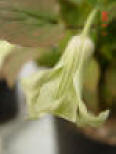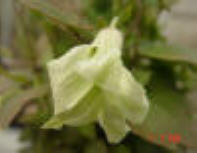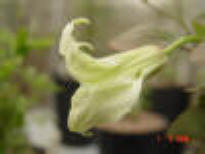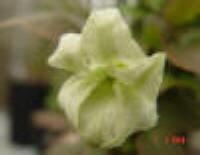Scroll down ↓ to earlier dates.
Change, we know, never spares us. It is over. Goodbye to my 51 feet x 24 feet house (and the period of being able to enjoy 350+ brand new clematis, changing every year, and the wonderful flowerings in massive volume I had in it). Back to my two (8x6 and 10x6) home greenhouses.
Item 9th September 2008
Bengt's var. kuripoensis given to me as a tiny seedling last year.
Susan Wilson's mystery plant.
Keith - the morefieldii - flowers - my camera is still not working properly but I did manage one or two reasonable ones. I noticed last year, on the photos you lent me, the secondary flowers but I was quite surprised when I got in tonight and after work and checked the plants. It was almost dark so I had to use the flash, so the pics are a bit hazy, but some are good. Here is the pitcheri Iris gave me earlier this year, it is a real beaut of a plant and the flowers are lovely, can't wait to hybridise with them. Also here is a new texensis from seed germinated 18months ago.
Iris's pitcheri a new texensis seedling
FAO Marcel Floyd
Hi Marcel, they are not brilliant photos. When you expand them they are large images so you can take a good look. Hope you like 'em. What's your little girl's name?
See what you think and please give me a bell. I will remove the photos in a day or two.
Beautiful blooms of new seedlings of Clematis patens coming into flower, on old wood, some already exhibiting a tendency to doubleness. The flowers will be much larger next year, when the seedlings have gotten along a little. But even now they are five inches across.
Pictures.........to follow tomorrow.
Up very early in the morning (with the camera) because when
I arrived home from work tonight I immediately spotted (flower radar) that
some of my brand-new 'Clematis patens' (reason for inverted commas in a
moment) seedlings had begun to open flowers. I'd been anticipating
the event for a few days!!
It was too dark to photograph them straight away, but tomorrow morning they
will be settled and just right.
These plants were grown from seeds produced by one of my other, earlier C.
patens plants, after flowering in 2004. The seed was sowed in October 2004
and began to visibly germinate in August 2005; 320 days or so. This is not
untypical for patens seed germinated by my standard old-fashioned method
using pots and normal compost, though they can often germinate earlier or
later than 320 days. Kristl's method would probably reduce the germination
time by two thirds!!!
When raising open-pollinated seeds one can only say 'raised as' because as
well as other C. patens plants there were also many other (compatible and
potentially compatible) clematis in flower, in my greenhouse, at that same
time. So it is possible that something else may have been involved. However,
they are, at a glance, certainly very close to C. patens, at least.
Germination in the middle of the season is highly convenient,,,you get the
whole remainder of the clement season to bring them on, before they feel
their first winter. By then, they are usually (in relative terms for very
small plants in 4-inch pots) well and truly established, in the sense that
the root mass has passed a critical point and the plant has a sufficient and
reasonably extensive grip on the medium. At winter's arrival the seedlings
behave just like the adults, the foliage undergoing the normal autumnal
dieing-off, followed by rotting and the ultimate shedding of the old
material.
Other seedlings are not so obliging and germinate just at the onset of winter!! No time for the tiny seedlings to become more mature prior to the onset of shortening and cooling days, nevertheless they cope remarkably well and the majority will still make it through the winter, with a little care and attention through the coldest spells. From time to time they have a knack of germinating right in the depths of the coldest spells!! But again they are resilient, with attention. Or you can heat the house if you wish!
Once past the early seedling stages and into extension growth, the middle-season germinators can sometimes develop reasonable lengths of vine, and, given sufficient time, these vines will ripen and harden somewhat and darken from the initial green, eventually to brown. If these initial growths are tied carefully to stakes at intervals as they extend, it is easy to protect them from breakage, and they will often persist over winter, even if the extremities die off. The vines are easy to manipulate and tend. In spring, these previous-season old vines may carry flower buds. (You may yet have to wait for the first flower until later in the season or next year; in which case, you do just the same thing.......preserve some of the old vines for the next season. They will almost certainly produce early season flowers the next time around.)
Pretty soon a DNA test to further characterise our seedlings will become routine. It will result in groups of recognisable patterns between the species and hybrids - as you'd expect. We could do with it now but.....
(Plant raised as) Clematis pitcheri begins to form flowers:



 Thank you to Iris Clarke for this lovely plant.
Thank you to Iris Clarke for this lovely plant.
Another new patens
×
coactilis seedling bears interesting pretty flowers.

 I am hoping the plant retains the green edges to the sepals but only time
will tell.
I am hoping the plant retains the green edges to the sepals but only time
will tell.
I am looking for a dedicated amateur local clematis/gardening/plant enthusiast/maybe interested in botany to some degree but not essential, who has a larger garden, in which to grow some of my new seedlings (such as the above) to maturity in the coming years. Interested? bcollingwood@ntlworld.com
A seedling (G177A) of C. patens × C. coactilis:
Last autumn this particular plant produced several small first
flowers, but it was already late in the season, and just quite how they
might appear this time around was... hard to say.
I don't know how a mature plant might look; In spring, maybe a dense clump
of shortish slight vines, growing to perhaps a foot or 18" or more (I'm
guessing) but with flowers like this, on many shoots. Then after first
flowering/pruning the newer vines begin to extend rapidly, like other
clematis, to about 1-2 metres (guessing from how things looked last year,
and the parentage) and then come into flower again in August or a little
later (as last year).
7th April 2008
Amazing plants....this one (of the series) produces early flowers on short vines which have been produced before the main extension growth gets under way, as you can see above, but then the next new vines start to elongate rapidly (as you can see also above) and these longer vines will carry clusters of pairs of flowers in the several nodes below the terminal flower, later in the season.
Some plants as they are in the 'house today.
A little integrifolia var. latifolia

 my clone of cylidrica
my clone of cylidrica
two clones plus cuttings of Ian Lang's new viticella-derived
(gorgeous red flowers) hybrid

a new baby clematis texensis

 another stunning new C. texensis baby
another stunning new C. texensis baby
a nice new viorna-group hybrid
 a taste of the completely wonderful first flowers which I am desperate to
see again on a slightly more mature seedling!
a taste of the completely wonderful first flowers which I am desperate to
see again on a slightly more mature seedling!


 No, it isn't C. crispa!!
No, it isn't C. crispa!!
a new C. texensis seedling

 another new texensis with interesting foliage
another new texensis with interesting foliage
a new viorna-group seedling

 a new C. crispa
a new C. crispa
a new texensis seedling

 another texensis baby
another texensis baby
a young var. scottii

 raised as glaucophylla
raised as glaucophylla
unknown clematis species from Nepal - seedling

really bad photo of
 a crispa-derived plant
a crispa-derived plant



 var. kuripoensis seedling from Bengt, beautiful foliage
var. kuripoensis seedling from Bengt, beautiful foliage
Item March 31st 2008
(Grown as) Clematis ochroleuca - seedling germinated by Bengt Sundström - seed from Gothenburg Botanic Garden. The seedling was kindly given to me by Bengt when he called at my greenhouse in March 2007. The plant and first flower:
This plant doesn't know it yet but it has a date
with a certain Miss C. patens
 in just a few weeks' time.
in just a few weeks' time.
---------------------
Item March 30th 2008
Hybridise your own clematis. The excitement is total. Don't miss out on the chance to get it done, this season. It is easy even for us amateurs. You'll get it in a routine even just after the first couple of tries. Select the parents and speculate about the possibilities. You marvel as you watch the successful development of the seeds and with incredulity you anticipate towards what magic potential might be stored in the seeds. Then, they germinate!! - a tremendous thrill to see seed from your own hybridisations beginning to produce plants. From this point you get to witness the unfolding daily development of the brand-new seedlings through all the stages of the new foliage, to when the unique plants begin to form their very first flowers!!! Then, your new flowers open!
Document is 7.8 megabytes and will take some time to download.
Item 7th January 2008
BCS Journal, The Clematis 2007, published.
End of page









































































